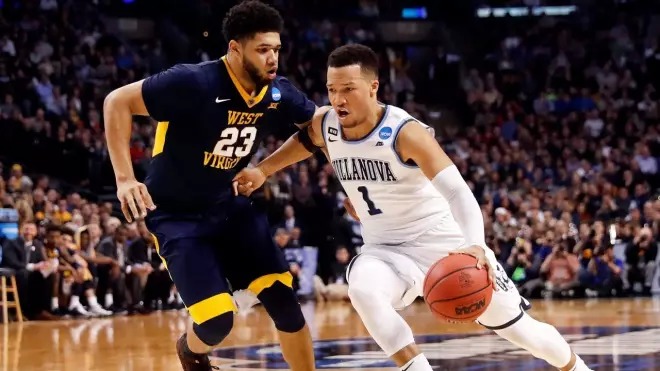Taking shots at the Big 12 Conference is a can’t miss proposition. The league often fails to see the forest for the trees which gives folks like Your Veteran Scribe plenty of chances to use hindsight to second-guess decisions that turned out incorrect.
It’s often as satisfying as filling up at the all-you-can-eat buffet. However, being vindictive toward the Big 12 should also be balanced with a fair take when the conference does something right.
Staying ahead of the college sports game has rarely been a Big 12 strength. But last October, the conference announced that it was being proactive in terms of non-conference scheduling.
Starting next season, the Big 12 and the Big East Conference will begin a four-year scheduling agreement. That will supplement the Big 12-SEC Challenge that is played on the final Saturday of January each season. The Big 12-SEC series started in 2014 and the Big 12 has won four times.
It’s a fair question to ask why the Big 12 needs another head-to-head event with another conference. Here’s where the conference’s crystal ball was crystal clear.
“We’ve been looking at this for some time,” commissioner Bob Bowlsby said during Big 12 basketball media day. “When some of the other peer conferences started talking about going to 20 conference games, we wanted a way to get some additional quality nonconference games. It ought to be a very good thing for both leagues.”
Big 12 hoops hangs its hat on an 18-game round-robin schedule which is a perfect schedule for a 10-team league. That rigorous home and home grind is a major reason why the Big 12 has been ranked and rated as one of the nation’s top conferences over the past few seasons.
Supplementing that league schedule with nonconference contests will be more difficult as the pool of potential opponents figures to shrink.
The 14-team Big Ten will play 20 conference games next season. In 2019-20, the Atlantic Coast Conference (which has 15 schools in basketball) will go to 20 conference games. The 14-team SEC and the 12-team Pac-12 are considering going to 20 games.
Again, why? All four of those conferences have their own network and the conference networks would rather televise conference games. Also, playing 20 league games helps teams build an incestuous strength of schedule that, in theory, can sway the NCAA Tournament men’s basketball committee when it comes to selecting at-large teams.
When the Big 12 started its challenge series with the SEC, the “It Just Means More” conference was playing inferior basketball. However, an infusion of outstanding coaches and a rededication to the sport has the SEC on the rise. Facing 10 SEC teams – even if the games are inconveniently in the middle of conference play – is a benefit for the Big 12.
As is the Big East scheduling agreement. The games will be played in November or December on campus venues. Big 12 teams who host SEC teams in that challenge will probably have road games against Big East teams.
The two challenge games mean that Big 12 schools will only need to find 10 or so nonconference games. And while it might be difficult to believe, scheduling is a challenge for at least eight of the league’s schools.
Kansas, one of the sport’s iconic programs, annually plays either Michigan State, Kentucky or Duke as part of the Champions Classic plus the Jayhawks can pick and choose a few marquee matchups. This season, they played Tennessee and defending national champion Villanova.
Texas has enough of a brand name that it can also schedule “up.” This season the Longhorns played North Carolina, Michigan State and Purdue.
The other Big 12 schools have a tough time convincing schools from the “big boy” conferences to schedule home-and-home. Few schools will charter for a nonconference game which means you “can’t get there from anywhere” when it comes to traveling to places like Waco, Lubbock, Ames, Stillwater or Manhattan.
“Kansas and Texas, it seems like they can always get games,” Kansas State coach Bruce Weber said. “But other people can’t get the tough games or home games, because we’re tougher to get to sometimes.”
Last off-season, Weber worked the phones trying to schedule some upscale foes. The Wildcats were coming off an Elite Eight appearance and were returning its starting lineup and top reserves. That, plus the hassle of reaching the Little Apple, produced the same answer.
“Basically, ‘screw you,’” Weber paraphrased the responses. “We had a game with a high-level West Coast team that doesn’t charter. They were all set, home and home, they were coming to our place first. Once they figured out the logistics, they backed out.”
Apparently, the folks scheduling for that high-level West Coast team never studied geography.
“Because of our location, sometimes it’s tough to schedule good nonconference games,” Baylor coach Scott Drew said. “That’s why the challenge series with the Big East and the SEC are great. We know we’ll have two quality games each year with one of those in Waco.”
When the Big 12 announced the agreement with the Big East at media day last October, it was referred to as a “non-conference scheduling series.” Bowlsby said it was a conscious move to not refer to it as a “challenge” because that term is becoming overused.
Fair point. Conjuring a name for the “scheduling series” is the next “challenge.” Maybe it’s best to let the folks in the Big East office or its television partner tap dance on that landmine. A stupid/silly, acronym friendly label could tarnish the product.
(From 2007-10, the Big 12 and the Pac-10 engaged in the “Big 12/Pac-10 Hardwood Series.” The name wasn’t the reason it lasted just four seasons but “Hardwood Series” sounds like a cable show sponsored by Home Depot.)
For now, the Big 12 can embrace its foresight and worry about what it’s called later.







